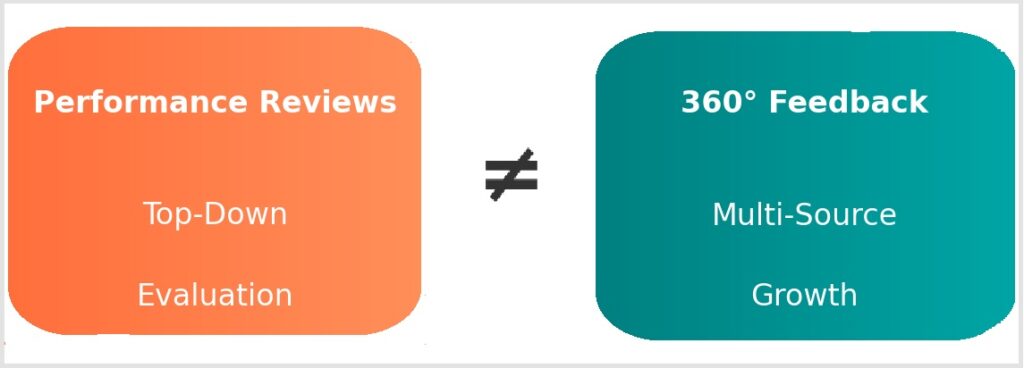
Performance Evaluations vs. 360-Degree Feedback: Key Differences and Implications
I’ve previously written about my love-hate relationship with Performance Management here but having said that – many organizations are continuously looking for effective methods to assess and enhance employee performance and I’m going to talk about two of the most commonly used ones in business today. Neither is specifically better than the other, they can be complementary systems that together create a comfortable workplace.
They are traditional performance evaluations and 360-degree feedback. While both serve to provide insights into an employee’s strengths and areas for improvement, they differ significantly in methodology, objectives, and impact on professional growth. This blog post explores these differences and examines the implications for both employees and organizations. Ultimately the success of any of these programs comes down to trust in the individuals participating in the process.
Traditional Performance Evaluations: A Top-Down Approach
Performance evaluations, also known as performance appraisals, are a structured assessment of an employee’s job performance, typically conducted by a direct supervisor. These evaluations often occur annually or semi-annually and focus on predefined performance metrics, job competencies, and goal achievements.
Characteristics of Performance Evaluations:
- Conducted by a single evaluator (usually a direct manager).
- Based on predefined goals and job descriptions.
- Typically includes a rating or ranking system.
- Often tied to promotions, salary increments, and bonuses.
- Primarily assesses past performance rather than future potential.
According to the research on Performance Evaluation and its Effects on Employees’ Job Motivation in Hamedan City Health Centers, performance appraisals are a crucial tool for employee motivation when conducted fairly and effectively. However, the study also highlighted challenges such as biased assessments, lack of comprehensive evaluation criteria, and the tendency to focus on past performance rather than ongoing development.
360-Degree Feedback: A Holistic Perspective
Unlike traditional performance evaluations, 360-degree feedback is a multi-rater assessment process that gathers feedback from multiple sources, including supervisors, peers, subordinates, and sometimes even clients. The goal of this approach is to provide a well-rounded perspective on an employee’s performance, leadership, and interpersonal skills.
Characteristics of 360-Degree Feedback:
- Involves feedback from multiple stakeholders (managers, peers, subordinates, and clients).
- Focuses on qualitative insights rather than numerical ratings.
- Encourages self-reflection and personal development.
- Not directly linked to salary or promotions (though it may inform development plans).
- Highlights behavioral competencies and leadership potential.
According to Harvard Business Review’s article, “Getting 360-Degree Feedback Right,” the effectiveness of this method depends on how it is implemented. If done well, it fosters a culture of continuous learning and self-improvement. However, poorly executed 360-degree feedback can lead to confusion, mistrust, and even workplace conflict if feedback is not framed constructively.
Key Differences Between Performance Evaluations and 360-Degree Feedback
| Feature | Performance Evaluation | 360-Degree Feedback |
|---|---|---|
| Evaluator(s) | Supervisor | Multiple sources (peers, managers, subordinates, clients) |
| Focus | Past performance and goal achievement | Behavioral competencies, leadership, teamwork, interpersonal skills |
| Feedback Type | Numeric ratings and formal assessments | Qualitative insights and developmental feedback |
| Impact on Career | Direct influence on promotions and compensation | Primarily for personal growth and leadership development |
| Frequency | Annually or semi-annually | Can be periodic or continuous |
Impact on Employees and Individual Experiences
The way employees experience these processes can greatly influence their career growth, job satisfaction, and motivation. Performance evaluations, while structured, can sometimes feel impersonal or overly focused on past achievements rather than future potential. Employees who receive ratings that don’t align with their self-perception may feel discouraged or disengaged.
360-degree feedback, on the other hand, allows employees to receive a more nuanced view of their performance. However, the process can be overwhelming, particularly if the feedback is inconsistent or lacks clear action points. Employees may struggle with conflicting opinions and may require guidance on how to prioritize and act on the feedback effectively.
Employee Expectations and Managing Perceptions
Employees often enter performance evaluations and 360-degree feedback with specific expectations. Some expect validation for their efforts, while others may anticipate clear next steps for career progression. To manage expectations effectively:
- Understand the Purpose: Recognizing that traditional performance evaluations are often tied to compensation and promotions, while 360-degree feedback is more developmental, can help employees set realistic expectations.
- Seek Clarification: If feedback is unclear or unexpected, employees should proactively seek additional context from their managers or HR.
- Focus on Growth: Rather than viewing evaluations as a judgment, employees should see them as opportunities for development.
- Balance Feedback: Constructive criticism should be weighed alongside positive feedback to avoid an emotional response that might overshadow useful insights.
How SkillProfile is Making 360 Reviews More Individualized
Many organizations are now leveraging technology to make feedback processes more tailored and impactful. SkillProfile is at the forefront of this movement by reimagining 360-degree reviews to be more individualized, actionable, and development-focused. Unlike traditional methods that rely on generic rating scales, SkillProfile incorporates:
- AI-driven insights that analyze strengths and areas for improvement based on real performance data.
- Personalized growth plans that help employees focus on actionable next steps.
- Real-time feedback integration to make the process more continuous rather than a once-a-year event.
By making feedback more specific and growth-oriented, SkillProfile ensures that employees receive insights that are relevant, empowering, and aligned with their professional goals.
Final Thoughts
Both performance evaluations and 360-degree feedback have unique benefits and challenges. Traditional performance evaluations offer structure and clarity but can be limited in scope. 360-degree feedback, on the other hand, provides a broader perspective but requires careful implementation to be effective. Organizations that strategically combine these methods can foster both accountability and professional growth, leading to a more motivated and high-performing workforce.
With solutions like SkillProfile, organizations can enhance the feedback experience by making it more personal, engaging, and actionable—helping employees not only understand where they stand but also how to grow in their careers. Learn more here http://www.skillprofile.com

